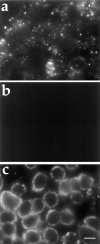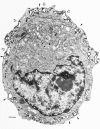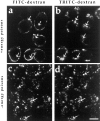Sphingomyelinase treatment induces ATP-independent endocytosis
- PMID: 9425152
- PMCID: PMC2132600
- DOI: 10.1083/jcb.140.1.39
Sphingomyelinase treatment induces ATP-independent endocytosis
Abstract
ATP hydrolysis has been regarded as a general requirement for internalization processes in mammalian cells. We found, however, that treatment of ATP-depleted macrophages and fibroblasts with exogenous sphingomyelinase (SMase) rapidly induces formation of numerous vesicles that pinch off from the plasma membrane; the process is complete within 10 min after adding SMase. By electron microscopy, the SMase-induced vesicles are approximately 400 nm in diameter and lack discernible coats. 15-30% of plasma membrane is internalized by SMase treatment, and there is no detectable enrichment of either clathrin or caveolin in these vesicles. When ATP is restored to the cells, the SMase-induced vesicles are able to deliver fluid-phase markers to late endosomes/lysosomes and return recycling receptors, such as transferrin receptors, back to the plasma membrane. We speculate that hydrolysis of sphingomyelin on the plasma membrane causes inward curvature and subsequent fusion to form sealed vesicles. Many cell types express a SMase that can be secreted or delivered to endosomes and lysosomes. The hydrolysis of sphingomyelin by these enzymes is activated by several signaling pathways, and this may lead to formation of vesicles by the process described here.
Figures









Similar articles
-
Maturation of early endosomes and vesicular traffic to lysosomes in relation to membrane recycling.J Cell Sci. 1995 Apr;108 ( Pt 4):1791-803. doi: 10.1242/jcs.108.4.1791. J Cell Sci. 1995. PMID: 7542261
-
Sorting of an internalized plasma membrane lipid between recycling and degradative pathways in normal and Niemann-Pick, type A fibroblasts.J Cell Biol. 1990 Aug;111(2):429-42. doi: 10.1083/jcb.111.2.429. J Cell Biol. 1990. PMID: 2380243 Free PMC article.
-
Sphingomyelinase and membrane sphingomyelin content: determinants ofProximal tubule cell susceptibility to injury.J Am Soc Nephrol. 2000 May;11(5):894-902. doi: 10.1681/ASN.V115894. J Am Soc Nephrol. 2000. PMID: 10770967
-
Receptor-mediated endocytosis: the intracellular journey of transferrin and its receptor.Biochimie. 1986 Mar;68(3):375-81. doi: 10.1016/s0300-9084(86)80004-9. Biochimie. 1986. PMID: 2874839 Review.
-
Relationship between ultrastructure and specific functions of macrophages.Comp Immunol Microbiol Infect Dis. 1985;8(2):119-33. doi: 10.1016/0147-9571(85)90039-6. Comp Immunol Microbiol Infect Dis. 1985. PMID: 3910340 Review.
Cited by
-
Bucket lists must be completed during cell death.Trends Cell Biol. 2023 Sep;33(9):803-815. doi: 10.1016/j.tcb.2023.02.008. Epub 2023 Mar 22. Trends Cell Biol. 2023. PMID: 36958996 Free PMC article. Review.
-
Dynamin-Independent Mechanisms of Endocytosis and Receptor Trafficking.Cells. 2022 Aug 17;11(16):2557. doi: 10.3390/cells11162557. Cells. 2022. PMID: 36010634 Free PMC article. Review.
-
Identification of Sphingomyelinase on the Surface of Chlamydia pneumoniae: Possible Role in the Entry into Its Host Cells.Interdiscip Perspect Infect Dis. 2014;2014:412827. doi: 10.1155/2014/412827. Epub 2014 Mar 13. Interdiscip Perspect Infect Dis. 2014. PMID: 24757444 Free PMC article.
-
Massive glycosaminoglycan-dependent entry of Trp-containing cell-penetrating peptides induced by exogenous sphingomyelinase or cholesterol depletion.Cell Mol Life Sci. 2015 Feb;72(4):809-20. doi: 10.1007/s00018-014-1696-y. Epub 2014 Aug 12. Cell Mol Life Sci. 2015. PMID: 25112713 Free PMC article.
-
Endophilin-A2 functions in membrane scission in clathrin-independent endocytosis.Nature. 2015 Jan 22;517(7535):493-6. doi: 10.1038/nature14064. Epub 2014 Dec 17. Nature. 2015. PMID: 25517096 Free PMC article.
References
-
- Allan D, Walklin CM. Endovesiculation of human erythrocytes exposed to sphingomyelinase C: a possible explanation for the enzyme-resistant pool of sphingomyelin. Biochim Biophys Acta. 1988;938:403–410. - PubMed
-
- Bednarek SY, Orci L, Schekman R. Traffic COPs and the formation of vesicle coats. Trends Cell Biol. 1996;6:468–473. - PubMed
-
- Callahan JW, Jones CS, Davidson DJ, Shankaran P. The active site of lysosomal sphingomyelinase: evidence for the involvement of hydrophobic and ionic groups. J Neurosci Res. 1983;10:151–163. - PubMed
-
- Chatterjee S. Neutral sphingomyelinase. Adv Lipid Res. 1993;26:25–48. - PubMed
Publication types
MeSH terms
Substances
Grants and funding
LinkOut - more resources
Full Text Sources
Other Literature Sources

